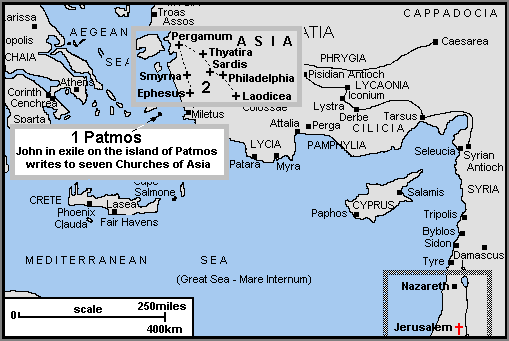Ignatius was born in Syria and was probably rather young when he converted to Christianity. St. Peter was the first bishop of Antioch, a town on the northeastern shore of the Mediterranean. Before leaving for Rome, Peter consecrated Ignatius the third bishop after Evodius, about 67AD. It is very likely that both Ignatius and his friend Polycarp, who was eventually bishop of Smyrna, were disciples of St. John in his later years. Smyrna, Ephesus and Patmos are within easy access of one another, probably just a few days journey from one anther. They are all on the coast of what is now the eastern side of Turkey.
He was a very caring spiritual father.
Ignatius represented Christianity in transition from its Jewish origins to its assimilation in the Greco-Roman world. He laid the foundation for dogmas that would be formulated in succeeding generations. He advocated a hierarchical structure of the church with emphasis on episcopal authority. He insisted on the real humanity of Christ, thus arguing against the Docetists who insisted that the suffering and death of Christ were not real. He set up the arguments which would be used against the Gnostics, who were just coming into being at this time.In 107 AD, Trajan, the emperor, visited the city of Antioch where he invited all religions to worship the Roman gods. Ignatius, who had been bishop for forty years, refused, knowing the consequences of his behavior. Ignatius and others were manacled and taken on their way to Troas to board a ship for Rome. Ignatius, a well-known personality in the Christian community by then, was followed by church members along the way to spiritually support him. One might picture the soldiers giving latitude to these people, as long as they kept walking. After all, the soldiers had a time constraint. For some reason, they stopped in Smyrna where he met Polycarp, the bishop. The two became friends and communicated as long as Ignatius could. Ignatius was also met by bishops and representatives of the nearby churches, such as Ephesus, who looked after his needs and gave him strength. We know this because he wrote letters of thanks after they left and some are extant.
Eventually, the soldiers and prisoners got to Troas where he again sent off letters and heard from friends in Antioch that the church there was “at peace”, thus relieving him of anxiety for his people. He took the ship for Rome and was exhibited for entertainment purposes where he was mauled to death by two lions. Polycarp’s disciple, Irenaeus, recorded the spectacle and sent letters to the churches reminding the people of the love Ignatius had for the Lord.
Seven letters which Ignatius wrote during his journey to Rome are extant today. They discuss orthodoxy and orthopraxy, the right beliefs and the right practices of the faith. They are the basis, along with Paul’s work, for much of the theology of the Church. He was the first to use the term “catholic church”, indicating universal.
St. Ignatius is the patron saint of Asia Minor. Dear Saint Ignatius, pray for us.
“Do not have the name of Jesus Christ upon your lips and worldly desires in your hearts.”
St. Ignatius


Recent Comments